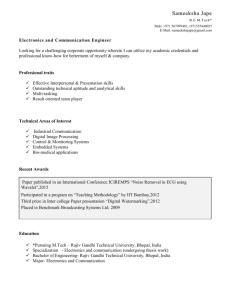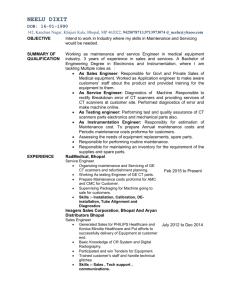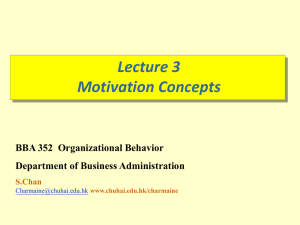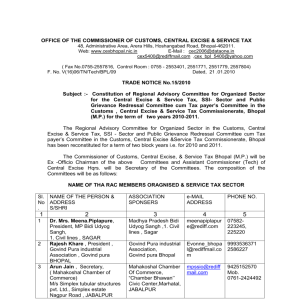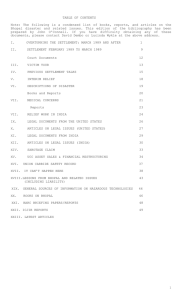Core Concepts of Marketing - Hindustan Studies and Services Ltd.
advertisement
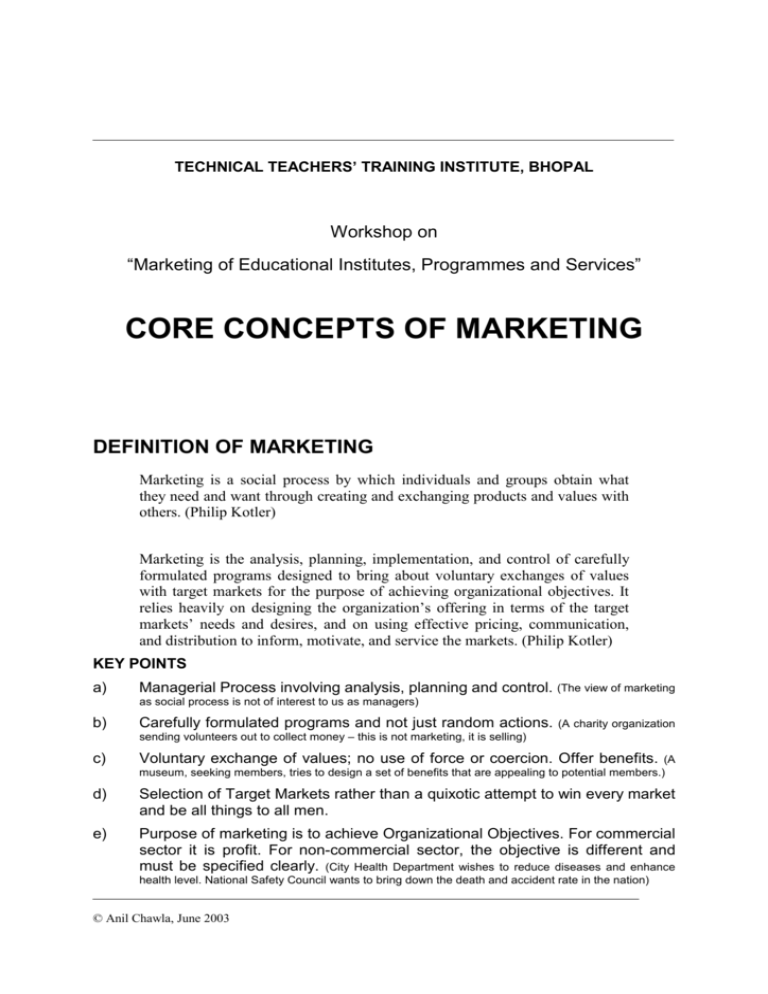
TECHNICAL TEACHERS’ TRAINING INSTITUTE, BHOPAL Workshop on “Marketing of Educational Institutes, Programmes and Services” CORE CONCEPTS OF MARKETING DEFINITION OF MARKETING Marketing is a social process by which individuals and groups obtain what they need and want through creating and exchanging products and values with others. (Philip Kotler) Marketing is the analysis, planning, implementation, and control of carefully formulated programs designed to bring about voluntary exchanges of values with target markets for the purpose of achieving organizational objectives. It relies heavily on designing the organization’s offering in terms of the target markets’ needs and desires, and on using effective pricing, communication, and distribution to inform, motivate, and service the markets. (Philip Kotler) KEY POINTS a) Managerial Process involving analysis, planning and control. (The view of marketing as social process is not of interest to us as managers) b) Carefully formulated programs and not just random actions. (A charity organization sending volunteers out to collect money – this is not marketing, it is selling) c) Voluntary exchange of values; no use of force or coercion. Offer benefits. (A museum, seeking members, tries to design a set of benefits that are appealing to potential members.) d) Selection of Target Markets rather than a quixotic attempt to win every market and be all things to all men. e) Purpose of marketing is to achieve Organizational Objectives. For commercial sector it is profit. For non-commercial sector, the objective is different and must be specified clearly. (City Health Department wishes to reduce diseases and enhance health level. National Safety Council wants to bring down the death and accident rate in the nation) © Anil Chawla, June 2003 Core Concepts of Marketing TTTI, Bhopal f) Marketing relies on designing the organization’s offering in terms of the target market’s needs and desires rather than in terms of seller’s personal tastes or internal dynamics. User-oriented and not seller-oriented. g) Marketing utilizes and blends a set of tools called the marketing mix – product design, pricing, distribution and communication. Too often marketing is equated either with just advertising or with just personal selling. MARKETING vs. SELLING There will always, one can assume, be need for some selling. But the aim of marketing is to make selling superfluous. The aim of marketing is to know and understand the customer so well that the product or service fits him and sells itself. Ideally, marketing should result in a customer who is ready to buy. All that should be needed then is to make the product or service available. (Peter Drucker) Examples: Sony’s Walkman, Nintendo’s superior video game Marketing includes selling but should be preceded by needs assessment, marketing research, product development, pricing and distribution. Marketing based on hard selling carries high risk. Dissatisfied customers. Selling FOCUS MEANS Products Aggressive Selling and Sales Promotion with emphasis on price variations to close the sale. “I must ENDS Maximize profits through sales volume somehow hook the customer” Marketing Customer Integrated Marketing Plan Needs encompassing product, price, promotion and distribution, backed up by adequate environmental scanning, consumer research, and opportunity analysis with emphasis on service. “What can we Maximize profits through increased customer satisfaction and hence raise market share. do that will make us, in the customer’s eyes, better than and superior to our competitors.” Example: M. Institute is an institute specializing in preparing students for CAT. It opened a branch at Bhopal in June 2002. To open the branch, it recruited the following persons: Branch Manager (BM), Marketing Executive (ME), Student Counselor (SC), Operations Executive (OE) and an office boy. Faculty was not recruited initially. Page No. 2 Core Concepts of Marketing TTTI, Bhopal BM, ME and SC were responsible for selling. OE was responsible for administration of branch including housekeeping and accounting. Due to the efforts of selling team and an aggressive advertising campaign, more than twenty enrolments were done in various courses within the first two months. Faculty recruitment was done in a hasty manner within a week of first enrolments. Students of first batch complained of poor course material, inadequately prepared faculty, and absenteeism of faculty. In the months from November 2002 to January 2003, there have been no fresh enrolments. By the end of January 2003, M. Institute had sacked its complete original selling team and had advertised for fresh executives who could give commitments about meeting targets of enrolments. BENEFITS & CRITICISMS OF MARKETING Benefits a) Improved Satisfaction of Target Market b) Improved efficiency in activities Criticism a) Marketing wastes money b) Marketing activity is intrusive c) Marketing is manipulative NATURE OF ORGANIZATIONS The Unresponsive Organization a) It does nothing to measure the needs, perceptions, preferences or satisfaction of its constituent publics. b) It makes it difficult for its constituent publics to place inquiries, complaints, suggestions or opinions. Examples: Sovereign, monopoly or high demand positions insulated from popular control. The Casually Responsive Organization a) It shows an interest in learning about consumer needs, perceptions, preferences, and satisfaction. b) It encourages consumers to submit inquiries, complaints, suggestions and opinions. Examples: US universities in early seventies faced decline in student applications. College administrators till then were largely oriented towards problems of hiring faculty, scheduling classes, and running efficient administrative services – the earmarks of the bureaucratic mentality. They started listening to students. They left their doors open, made occasional surprise appearances in the student lounge, encouraged suggestions from students, and created faculty-student committees. These steps converted the university organization into being informally responsive. Page No. 3 Core Concepts of Marketing TTTI, Bhopal The Highly Responsive Organization a) It shows a keen interest in learning about the needs, perceptions, preferences, and satisfaction of its constituent publics and relies on systematic information-collection procedures such as formal opinion surveys and consumer panels. b) It encourages its constituents to submit inquiries, complaints, suggestions, and opinions and creates formal systems to facilitate this, such as suggestion boxes, comment cards, ombudsmen, and consumer committees. c) It sifts the incoming information and takes positive steps where called for to adjust products, services, organizational policies, and procedures. Examples: Large progressive firms like Hindustan Lever, Proctor and Gamble. The Fully Responsive Organization Moving a step from Highly to Fully eliminates the difference between “them” and “us”, giving power of decision making to constituents. Examples: some churches, trade unions, associations and chambers of commerce. A Canadian University was searching for ways to build a more active alumni association. Just sending out newsletters about the school did not suffice to build up alumni pride or interest. It developed the idea of conferring membership status to its alumni, with certain privileges and voting rights on certain issues. Suddenly this group became alive with interest in the school. This gesture proved very meaningful to the alumni, which had hitherto felt that the university was simply using them for money. ORIENTATION OF ORGANIZATIONS a) Production Orientation – Arose in scarcity economies. Business concentrated on production output and efficiency. Finding customers easy; products kept simple and often quality scaled down to increase profits. b) Sales Orientation – Key assumptions are as follows: 1) The main task of the firm is to get sufficient sales for its products. 2) The consumer can be induced to buy through various sales stimulating techniques and devices. 3) The customer will probably come back again and even if he does not, there are many other customers out there. Examples: Encyclopedia salesmen, insurance agents, many Indian companies c) Marketing Orientation – The marketing concept is a consumers’ needs orientation backed by integrated marketing aimed at generating consumer satisfaction as the key to satisfying organizational goals. Page No. 4 Core Concepts of Marketing TTTI, Bhopal NATURE OF NEEDS A human need is a state of felt deprivation of some basic satisfaction. (food, clothing, shelter, safety, belonging, esteem etc.) Abraham Maslow noticed that some needs take precedence over others. For example, if you are hungry and thirsty, you will tend to try to take care of the thirst first. After all, you can do without food for weeks, but you can only do without water for a couple of days! Thirst is a “stronger” need than hunger. Likewise, if you are very thirsty, but someone has put a choke hold on you and you can’t breath, which is more important? The need to breathe, of course. On the other hand, sex is less powerful than any of these. Let’s face it, you won’t die if you don’t get it! Maslow took this idea and created his now famous hierarchy of needs. Beyond the details of air, water, food, and sex, he laid out five broader layers: 1) Physiological needs. These include the needs we have for oxygen, water, protein, salt, sugar, calcium, and other minerals and vitamins. They also include the need to maintain a pH balance (getting too acidic or base will kill you) and temperature. Also, there’s the needs to be active, to rest, to sleep, to get rid of wastes (CO2, sweat, urine, and feces), to avoid pain, and to have sex. 2) Safety and security needs. When the physiological needs are largely taken care of, this second layer of needs comes into play. You will become increasingly interested in finding safe circumstances, stability, protection. You might develop a need for structure, for order, some limits. Looking at it negatively, you become concerned, not with needs like hunger and thirst, but with your fears and anxieties. In the ordinary adult, this set of needs manifest themselves in the form of our urges to have a home in a safe neighborhood, a little job security and a good retirement plan and a bit of insurance, and so on. Page No. 5 Core Concepts of Marketing 3) TTTI, Bhopal Love and belonging needs. When physiological needs and safety needs are, by and large, taken care of, a third layer starts to show up. You begin to feel the need for friends, a sweetheart, children, affectionate relationships in general, even a sense of community. Looked at negatively, you become increasing susceptible to loneliness and social anxieties. In our day-to-day life, we exhibit these needs in our desires to marry, have a family, be a part of a community, a member of a church, a brother in the fraternity, a part of a gang or a bowling club. It is also a part of what we look for in a career. 4) Esteem needs. Next, we begin to look for a little self-esteem. Maslow noted two versions of esteem needs, a lower one and a higher one. The lower one is the need for the respect of others, the need for status, fame, glory, recognition, attention, reputation, appreciation, dignity, even dominance. The higher form involves the need for self-respect, including such feelings as confidence, competence, achievement, mastery, independence, and freedom. Note that this is the “higher” form because, unlike the respect of others, once you have self-respect, it’s a lot harder to lose! The negative version of these needs is low self-esteem and inferiority complexes. Maslow felt that these were at the roots of many, if not most, of psychological problems. In many countries, most people have what they need in regard to their physiological and safety needs. Almost everyone, more often than not, has quite a bit of love and belonging, too. It’s a little respect that often seems so very hard to get! All of the preceding four levels he calls deficit needs, or D-needs. If you don’t have enough of something -- i.e. you have a deficit -- you feel the need. But if you get all you need, you feel nothing at all! In other words, they cease to be motivating. As the old blues song goes, “you don’t miss your water till your well runs dry!” Maslow also talks about these levels in terms of homeostasis. Homeostasis is the principle by which a furnace thermostat operates: When it gets too cold, it switches the heat on; When it gets too hot, it switches the heat off. In the same way, our body, when it lacks a certain substance, develops a hunger for it; When it gets enough of it, then the hunger stops. Maslow simply extends the homeostatic principle to needs, such as safety, belonging, and esteem, that we don’t ordinarily think of in these terms. Under stressful conditions, or when survival is threatened, we can “regress” to a lower need level. Page No. 6 Core Concepts of Marketing TTTI, Bhopal These things can occur on a society-wide basis as well: When society suddenly flounders, people start clamoring for a strong leader to take over and make things right. When the bombs start falling, they look for safety. When the food stops coming into the stores, their needs become even more basic. If one has significant problems along one’s development -- a period of extreme insecurity or hunger as a child, or the loss of a family member through death or divorce, or significant neglect or abuse -- one may “fixate” on that set of needs for the rest of one’s life. WANTS AND DEMANDS Human wants are desires for specific satisfiers of these deeper needs. Demands are wants for specific products that are backed by an ability and willingness to buy them. VALUE AND SATISFACTION Value = Benefits Functional Benefits + Emotional Benefits = Costs Monetary Costs + Time Costs + Energy Costs + Psychic Costs Tools for tracking and measuring Customer Satisfaction: Complaint and Suggestion systems, Customer satisfaction surveys, Ghost shopping, Lost customer analysis Anil Chawla MF-104, Ajay Tower, E5/1 (Commercial), Arera Colony, BHOPAL - 462016, INDIA Tel. 91-755- 2736901, 2736902 (Res.) Fax 91-755-2661382 Website http://www.samarthbharat.com E-mail snacks@sancharnet.in hindustanstudies@rediffmail.com hindustanstudies@yahoo.co.in Page No. 7 Core Concepts of Marketing TTTI, Bhopal CLASS ASSIGNMENT Discuss the following cases: A. Newspaper Newspapers have been facing declining sales all over the world due to onslaught of television in the past two decades. However, some newspapers have suffered more than others. A rare few (like Bhaskar group) have managed to grow in spite of difficult times. The picture seems confusing. If you have to start a new newspaper in your town, what will be the key factors that you will devote your attention to? B. Restaurant Tusharbhai has a space of 2000 square feet at ground floor on a prime location in Vadodara. The place is walking distance from railway station and university. He is advised by his friends to start a restaurant in the place. He approaches a consultant for planning of the restaurant. Assume that you are the consultant. What are the issues, information, data, etc that you would devote your mind to? In other words, what questions would you like to ask and answer during the process of planning the restaurant? C. Casino Tusharbhai is politically very well connected. He feels that he can get permission from the relevant authorities for starting a casino at the above place. He asks the consultant to evaluate the marketing feasibility of a casino. Discuss the issues involved from a marketing perspective. Page No. 8


